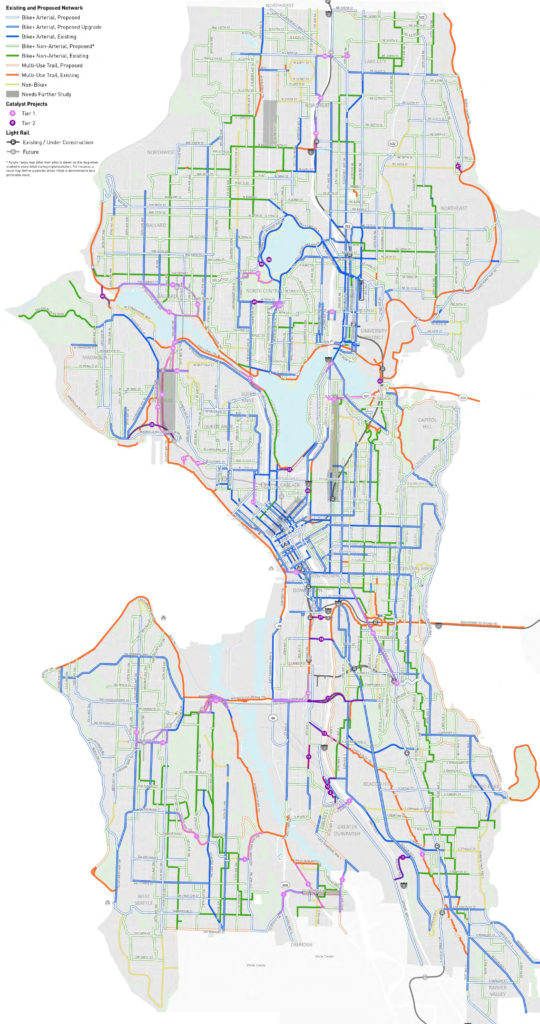Council passes the Seattle Transportation Plan with few changes
 The bicycle facilities map in the mayor's proposed Seattle Transportation Plan.
The bicycle facilities map in the mayor's proposed Seattle Transportation Plan.After making very few changes, the City Council passed the Seattle Transportation Plan (STP") this week, supplanting the 2014 Bicycle Master Plan and sending it to the city archives.
The STP is an ambitious document that attempts to combine all the city's modal plans and transportation priorities into a single mega plan, resolving as many modal conflicts in advance of project development. Project development should go much more smoothly since the guidance for each street has been predetermined at a high level. Or at least that is the city's hope. Now that the STP is official city policy, we will soon see how the framework holds up under pressure.
Seattle Bike Blog is still moving through our neighborhood-by-neighborhood analyses of the new plan, and posts about Central, NE and NW Seattle are coming soon. But the council did not have much of an appetite for making changes to the plan after it left Mayor Harrell's office. Aside from a handful of minor changes and some additional whereas clauses, these are the Council's substantive changes (PDF):
- Boost the section about building missing sidewalks
- Water down the 14th Ave NW bike lane in the plan
- Slightly water down the Pike Place Event Street proposal and rename it the Pike Place Access Review project (the adopted change is significantly less extensive than CM Kettle's initial suggestion to defund the project, which received a lot of pushback)
Additionally, Council added a section outlining what they would like to see from future implementation plans, which you can find in their omnibus amendment (PDF):
Section 6. The Council anticipates that the STP Implementation Plan will:
- A. Identify the implementation strategy for adding new sidewalks and sidewalk alternatives, and significantly closing the missing sidewalk gap;
- B. Identify the City's role and implementation strategy for improving the transit rider safety experience to ensure that passengers feel safe while accessing and using the transit system;
- C. Identify the implementation strategy for keeping bridges in a state of good repair and tracking progress on the Bridge Asset Management Plan;
- D. Estimate progress towards STP performance metrics based on likely funding from a renewed 2024 transportation levy and leveraged funding sources, over the lifetime of the levy;
- E. Explore programs to deter gun violence and drive by shootings through the use of traffic calming and traffic diversion near public schools and in areas with high levels of vehicle-involved violence; and
- F. Explore programs to improve pedestrian lighting in the right-of-way, including development of public safety lighting standards or guidelines, and opportunities to engage adjoining property owners in lighting the public right-of-way.
They also outlined what they would like to see from the next transportation levy, which the Council is set to begin discussing through a special committee that meets for the first time May 7:
Section 3. The Council anticipates that a proposal to renew the transportation levy will be presented to voters for the November 2024 election. The Council anticipates that such a proposal will prioritize:
- A. Improving the safety of Lake Washington Boulevard. [amended]
- B. Maintenance, preservation and modernization, including bridge maintenance and repairs, and street maintenance and repairs;
- C. Safety and mobility, including a once-in-a-generation investment in new sidewalks and sidewalk alternatives, along with pedestrian crossings, accessible pedestrian signals, and safe routes to schools;
- D. Climate action and livability, including electric vehicle charging infrastructure and improvements to the transit rider experience;
- E. Vision Zero programs and projects to eliminate deaths and serious injuries caused by vehicle crashes; and
- F. Improving on-time performance of transit in the Denny Way corridor.
Considering the sheer scale of this plan, it received surprisingly little attention and public debate. Either everyone is on board with all this stuff, or the thing was just too big and intimidating for people to engage with. The Bicycle Master Plan was much more heavily debated back in 2012, 2013 and 2014. On one hand, I am very happy that we did not spend another two-plus years arguing over the city's bicycle plan. That was a grueling process just to create some pieces of paper. However, it also gave SDOT the presumption of public buy-in, which they used to build high-profile projects like the 2nd Ave bike lane.
There is a lot of stuff in the STP that I expected people to push back against, but it didn't happen. There are a lot more protected bike lanes in the STP than the 2014 Bicycle Master Plan because the STP dramatically reduced the number of paint-only bike lanes and sharrows, and most of those projects got turned into protected bike lanes instead. This week, the Council just made them all official city policy.
But we are focused on the bike stuff here because this is Seattle Bike Blog. Bicycling is just one little section in the STP. There is so much more in this giant document that received little to no public debate. Considering how few changes the Council made, this plan is very clearly Mayor Bruce Harrell's transportation plan. If he can propose and pass a levy that funds 40% of this 20-year plan over the next 8 years-and SDOT is able to actually deliver that work-it will be a remarkable achievement in Seattle history. But the proposed levy is going to need to be significantly larger, and then it is going to require a lot of ongoing political on grassroots advocacy support.